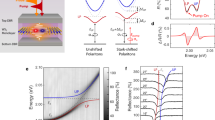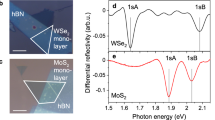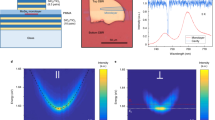Abstract
Single layers of transition metal dichalcogenides are two-dimensional (2D) direct-bandgap semiconductors with degenerate, but inequivalent, ‘valleys’ in the electronic structure that can be selectively excited by polarized light. Coherent superpositions of light and matter, exciton–polaritons, have been observed when these materials are strongly coupled to photons, but these hybrid quasiparticles do not harness the valley sensitivity of the monolayer semiconductors. Here, we observe valley-polarized exciton–polaritons in monolayers of MoS2 embedded in a dielectric microcavity. These light–matter quasiparticles emit polarized light with spectral Rabi splitting and anticrossing indicative of strongly coupled exciton–polaritons in the topologically separate spin-coupled valleys. The interplay of intervalley depolarization and cavity-modified exciton dynamics in the high-cooperativity regime causes valley-polarized exciton–polaritons to persist at room temperature, distinct from the vanishing polarization in bare monolayers. Achieving polarization-sensitive polaritonic devices operating at room temperature presents a pathway for manipulating novel valley degrees of freedom in coherent states of light and matter.
This is a preview of subscription content, access via your institution
Access options
Access Nature and 54 other Nature Portfolio journals
Get Nature+, our best-value online-access subscription
$29.99 / 30 days
cancel any time
Subscribe to this journal
Receive 12 print issues and online access
$209.00 per year
only $17.42 per issue
Buy this article
- Purchase on Springer Link
- Instant access to full article PDF
Prices may be subject to local taxes which are calculated during checkout




Similar content being viewed by others
References
Purcell, E. M. Spontaneous emission probabilities at radio frequencies. Phys. Rev. 69, 681 (1946).
Haroche, S. & Kleppner, D. Cavity quantum electrodynamics. Phys. Today 42, 24–30 (January, 1989).
Kimble, H. J. Strong interactions of single atoms and photons in cavity QED. Physica Scripta 1998, 127–137 (1998).
Reithmaier, J. P. et al. Strong coupling in a single quantum dot–semiconductor microcavity system. Nature 432, 197–200 (2004).
Yoshie, T. et al. Vacuum Rabi splitting with a single quantum dot in a photonic crystal nanocavity. Nature 432, 200–203 (2004).
Wallraff, A. et al. Strong coupling of a single photon to a superconducting qubit using circuit quantum electrodynamics. Nature 431, 162–167 (2004).
Weisbuch, C., Nishioka, M., Ishikawa, A. & Arakawa, Y. Observation of the coupled exciton-photon mode splitting in a semiconductor quantum microcavity. Phys. Rev. Lett. 69, 3314–3317 (1992).
Houdré, R. et al. Measurement of cavity-polariton dispersion curve from angle-resolved photoluminescence experiments. Phys. Rev. Lett. 73, 2043–2046 (1994).
Deng, H., Haug, H. & Yamamoto, Y. Exciton-polariton Bose-Einstein condensation. Rev. Mod. Phys. 82, 1489–1537 (2010).
Amo, A. et al. Exciton–polariton spin switches. Nat. Photon. 4, 361–366 (2010).
Sanvitto, D. & Kéna-Cohen, S. The road towards polaritonic devices. Nat. Mater. 15, 1061–1073 (2016).
Lenferink, E. J., Wei, G. & Stern, N. P. Coherent optical non-reciprocity in axisymmetric resonators. Opt. Express 22, 16099–16111 (2014).
Sayrin, C. et al. Nanophotonic optical isolator controlled by the internal state of cold atoms. Phys. Rev. X 5, 041036 (2015).
Söllner, I. et al. Deterministic photon–emitter coupling in chiral photonic circuits. Nat. Nanotech. 10, 775–778 (2015).
Junge, C., O'Shea, D., Volz, J. & Rauschenbeutel, A. Strong coupling between single atoms and nontransversal photons. Phys. Rev. Lett. 110, 213604 (2013).
Mak, K. F., Lee, C., Hone, J., Shan, J. & Heinz, T. F. Atomically thin MoS2: a new direct-gap semiconductor. Phys. Rev. Lett. 105, 136805 (2010).
Splendiani, A. et al. Emerging photoluminescence in monolayer MoS2 . Nano Lett. 10, 1271–1275 (2010).
Xiao, D., Liu, G.-B., Feng, W., Xu, X. & Yao, W. Coupled spin and valley physics in monolayers of MoS2 and other group-VI dichalcogenides. Phys. Rev. Lett. 108, 196802 (2012).
Mak, K. F., He, K., Shan, J. & Heinz, T. F. Control of valley polarization in monolayer MoS2 by optical helicity. Nat. Nanotech. 7, 494–498 (2012).
Zeng, H., Dai, J., Yao, W., Xiao, D. & Cui, X. Valley polarization in MoS2 monolayers by optical pumping. Nat. Nanotech. 7, 490–493 (2012).
Cao, T. et al. Valley-selective circular dichroism of monolayer molybdenum disulphide. Nat. Commun. 3, 887 (2012).
Kioseoglou, G. et al. Valley polarization and intervalley scattering in monolayer MoS2 . Appl. Phys. Lett. 101, 221907 (2012).
Wang, Q. H., Kalantar-Zadeh, K., Kis, A., Coleman, J. N. & Strano, M. S. Electronics and optoelectronics of two-dimensional transition metal dichalcogenides. Nat. Nanotech. 7, 699–712 (2012).
Sallen, G. et al. Robust optical emission polarization in MoS2 monolayers through selective valley excitation. Phys. Rev. B 86, 081301 (2012).
Mak, K. F., McGill, K. L., Park, J. & McEuen, P. L. The valley Hall effect in MoS2 transistors. Science 344, 1489–1492 (2014).
Rohling, N. & Burkard, G. Universal quantum computing with spin and valley states. New J. Phys. 14, 083008 (2012).
Behnia, K. Condensed-matter physics: polarized light boosts valleytronics. Nat. Nanotech. 7, 488–489 (2012).
Jones, A. M. et al. Optical generation of excitonic valley coherence in monolayer WSe2 . Nat. Nanotech. 8, 634–638 (2013).
Wang, G. et al. Control of exciton valley coherence in transition metal dichalcogenide monolayers. Phys. Rev. Lett. 117, 187401 (2016).
Gan, X. et al. Controlling the spontaneous emission rate of monolayer MoS2 in a photonic crystal nanocavity. Appl. Phys. Lett. 103, 181119 (2013).
Wu, S. et al. Control of two-dimensional excitonic light emission via photonic crystal. 2D Mater. 1, 011001 (2014).
Schwarz, S. et al. Two-dimensional metal–chalcogenide films in tunable optical microcavities. Nano Lett. 14, 7003–7008 (2014).
Wei, G., Stanev, T. K., Czaplewski, D. A., Jung, I. W. & Stern, N. P. Silicon-nitride photonic circuits interfaced with monolayer MoS2 . Appl. Phys. Lett. 107, 091112 (2015).
Liu, X. et al. Strong light–matter coupling in two-dimensional atomic crystals. Nat. Photon. 9, 30–34 (2015).
Dufferwiel, S. et al. Exciton–polaritons in van der Waals heterostructures embedded in tunable microcavities. Nat. Commun. 6, 8579 (2015).
Flatten, L. C. et al. Room-temperature exciton-polaritons with two-dimensional WS2 . Sci. Rep. 6, 33134 (2016).
Lundt, N. et al. Monolayered MoSe2: a candidate for room temperature polaritonics. 2D Mater. 4, 015006 (2017).
Paraïso, T. K., Wouters, M., Léger, Y., Morier-Genoud, F. & Deveaud-Plédran, B. Multistability of a coherent spin ensemble in a semiconductor microcavity. Nat. Mater. 9, 655–660 (2010).
Takemura, N., Trebaol, S., Wouters, M., Portella-Oberli, M. T. & Deveaud, B. Heterodyne spectroscopy of polariton spinor interactions. Phys. Rev. B 90, 195307 (2014).
Karzig, T., Bardyn, C.-E., Lindner, N. H. & Refael, G. Topological polaritons. Phys. Rev. X 5, 031001 (2015).
Low, T. et al. Polaritons in layered two-dimensional materials. Nat Mater. 16, 182–194 (2016).
Basov, D. N., Fogler, M. M. & Garca de Abajo, F. J. Polaritons in van der Waals materials. Science 354, aag1992 (2016).
Savona, V., Andreani, L., Schwendimann, P. & Quattropani, A. Quantum well excitons in semiconductor microcavities: unified treatment of weak and strong coupling regimes. Solid State Commun. 93, 733–739 (1995).
Plechinger, G. et al. Low-temperature photoluminescence of oxide-covered single-layer MoS2 . Phys. Status Solidi 6, 126–128 (2012).
Tongay, S. et al. Defects activated photoluminescence in two-dimensional semiconductors: interplay between bound, charged, and free excitons. Sci. Rep. 3, 2657 (2013).
Lagarde, D. et al. Carrier and polarization dynamics in monolayer MoS2 . Phys. Rev. Lett. 112, 047401 (2014).
Laussy, F. P., Del Valle, E. & Tejedor, C. Luminescence spectra of quantum dots in microcavities. I. Bosons. Phys. Rev. B 79, 235325 (2009).
Moody, G. et al. Intrinsic homogeneous linewidth and broadening mechanisms of excitons in monolayer transition metal dichalcogenides. Nat. Commun. 6, 8315 (2015).
Robert, C. et al. Exciton radiative lifetime in transition metal dichalcogenide monolayers. Phys. Rev. B 93, 205423 (2016).
Palummo, M., Bernardi, M. & Grossman, J. C. Exciton radiative lifetimes in two-dimensional transition metal dichalcogenides. Nano Lett. 15, 2794–2800 (2015).
Lee, Y.-H. et al. Synthesis of large-area MoS2 atomic layers with chemical vapor deposition. Adv. Mater. 24, 2320–2325 (2012).
Lin, Y.-C. et al. Clean transfer of graphene for isolation and suspension. ACS Nano 5, 2362–2368 (2011).
Park, H. J., Meyer, J., Roth, S. & Skákalová, V. Growth and properties of few-layer graphene prepared by chemical vapor deposition. Carbon 48, 1088–1094 (2010).
Acknowledgements
This research is supported by the US Department of Energy, Office of Basic Energy Sciences, Division of Materials Sciences and Engineering under award no. DE-SC0012130 (cavity spectroscopy), by the National Science Foundation MRSEC program under grant no. DMR-1121262 (transfer and device assembly), and by the National Science Foundation under grant no. DMR-1507810 (CVD growth). This work made use of the EPIC and KECK-II facilities of the NUANCE Center at Northwestern University, which has received support from the Soft and Hybrid Nanotechnology Experimental (SHyNE) Resource (NSF NNCI-1542205); the MRSEC program (NSF DMR-1121262) at the Materials Research Center; the International Institute for Nanotechnology (IIN); the Keck Foundation; and the State of Illinois, through the IIN. This work utilized Northwestern University Micro/Nano Fabrication Facility (NUFAB), which is partially supported by Soft and Hybrid Nanotechnology Experimental (SHyNE) Resource (NSF NNCI-1542205), the Materials Research Science and Engineering Center (NSF DMR-1121262), the State of Illinois, and Northwestern University. J.D.C. is supported by the Department of Defense through the National Defense Science and Engineering Fellowship (NDSEG) Program. J.D.C. also gratefully acknowledges support from the Ryan Fellowship and the IIN. N.P.S. acknowledges support as an Alfred P. Sloan Research Fellow.
Author information
Authors and Affiliations
Contributions
N.P.S. and Y.-J.C. conceived the experiments. Y.-J.C. fabricated the MC. J.D.C. and V.P.D. synthesized the monolayers. T.K.S. and Y.-J.C. performed material characterization and transfer. Y.-J.C. performed measurements and modelling. Y.-J.C. and N.P.S. co-wrote the paper. All authors discussed the results and commented on the manuscript.
Corresponding author
Ethics declarations
Competing interests
The authors declare no competing financial interests.
Supplementary information
Supplementary information
Supplementary information (PDF 2361 kb)
Rights and permissions
About this article
Cite this article
Chen, YJ., Cain, J., Stanev, T. et al. Valley-polarized exciton–polaritons in a monolayer semiconductor. Nature Photon 11, 431–435 (2017). https://doi.org/10.1038/nphoton.2017.86
Received:
Accepted:
Published:
Issue Date:
DOI: https://doi.org/10.1038/nphoton.2017.86



